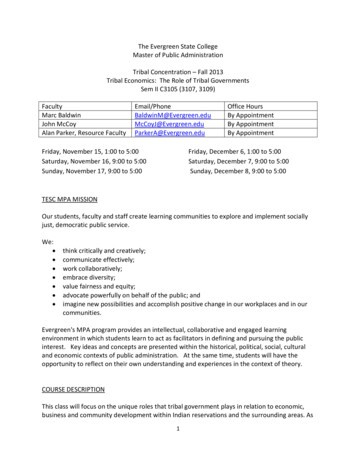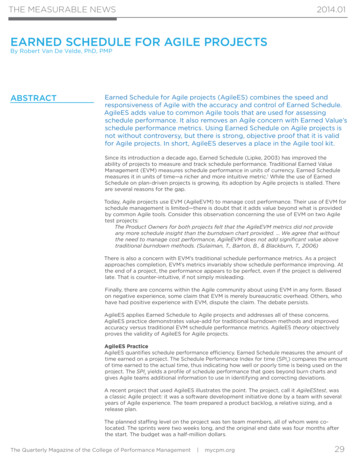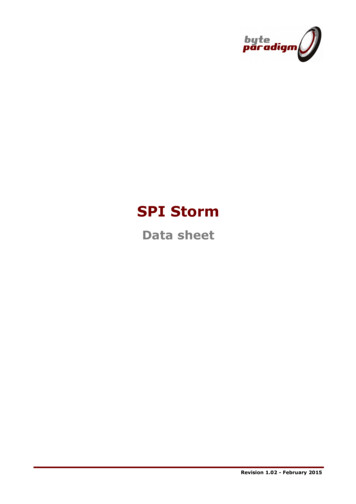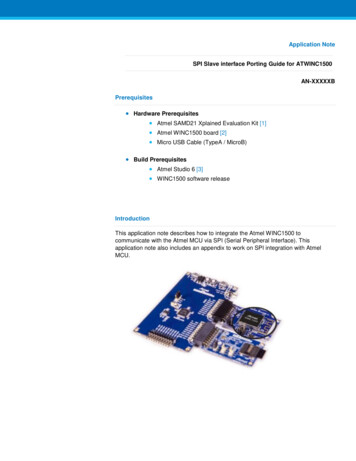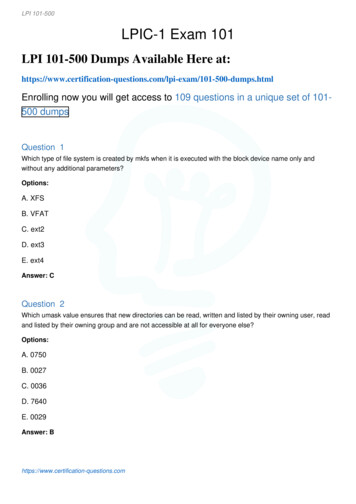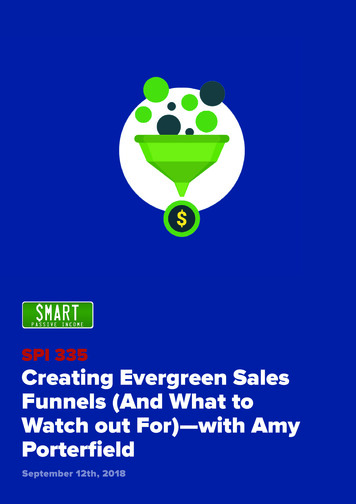
Transcription
SPI 335Creating Evergreen SalesFunnels (And What toWatch out For)—with AmyPorterfieldSeptember 12th, 2018
SHOW NOTES: http://www.smartpassiveincome.com/session335Amy Porterfield: When you go evergreen, I think a lot of old school marketers whotalk about evergreen, like make money in your sleep, you can gooff and play more, take time on the beach, get a tan, blah, blah,blah. I’ve experienced that evergreen still takes some focus. Everysingle week I’m dabbling a little bit in my evergreen funnels. Whereit happens for me the most would be in my . . .Pat Flynn:That’s Amy Porterfield, our special guest today who’s coming onto talk about evergreen funnels. If you don’t know what a funnelis, a funnel is how you take somebody from when they first findyou, to the next step, to the next step, to eventually a purchasedecision of some kind. Hopefully a customer is what they become.An evergreen sales funnel is one that happens automatically.You’ve set things up ahead of time so that the progression happensautomatically. What Amy’s saying there is that it’s not as automaticas some may make it out to be, so we’re going to get deep intowhat evergreen is, how to make it work, how Amy’s been doingwith it, some of the pluses and minuses, the pros and cons of it, andwhat you can do. Whether you already have a business or not, thisis a great way to start thinking.It’s like, I remember when I read The 4-Hour Work Week by TimFerriss. I didn’t even have a business yet back in 2008, but it wasinspiring because it showed me the right way to go about it. Thenwhen I finally built my business, I had built it in a way such that itwas mostly automated based on what I learned from Tim. Nowwe’re talking about not just sales funnels, but evergreen salesfunnels. Even if you don’t have a business, this will be very helpful.All you have to do—two things. Number one, hit subscribe if youhaven’t already. Number two, put that phone in that pocket becausethis is going to be a good one. Amy Porterfield’s with us, hit thatmusic.Announcer:Welcome to the Smart Passive Income Podcast, where it’s all aboutworking hard now, so you can sit back and reap the benefits later.And, now your host—he believes in JOMO, the Joy Of Missing Out—Pat Flynn!1
SHOW NOTES: http://www.smartpassiveincome.com/session335Pat Flynn:What’s up? Welcome everybody. Thank you so much for joiningme in Session 335 of the Smart Passive Income Podcast. I’m verythankful to have one of my best friends here in the online space,who is also with me in San Diego as well. We get coffee every oncein a while. I really wanted her to come back on the show to talkabout this, because I noticed that Amy had switched from a lot oflive launches—which is where you kind of have to work to have alaunch period between a certain amount of time, and it takes a lot ofeffort and work. Which is what I’m doing right now mostly, althoughwe are starting to experiment with evergreen. I don’t know muchabout it yet.What do I do when I don’t know much about something? I talk to asmany experts who have done that thing before, and that’s exactlywhy we have these experts like Amy here on the show. To not justshare with me, but share with you all the things we need to knowbefore we dive in, and go full force with it. Without further ado, let’sbring on Amy Porterfield from AmyPorterfield.com, and the OnlineMarketing Made Easy Podcast. Here she is.Amy, welcome back to the SPI Podcast. Thank you so much forbeing here again.Amy Porterfield: Well thanks so much for having me, I’m happy to be here.Pat Flynn:I was checking on the date of the last time you were on the show,and it was August 9th, 2017. So literally at the time of this recording,about a month, or a year ago to the day.Amy Porterfield: Too funny.Pat Flynn:I think I need to you have on more often, because that was a reallypopular episode. We’ve had you on before also to talk about courselaunches, last time it was list building. This time, we’re going tobe talking about not just creating courses, but how, and why, andshould we make them evergreen versus the live launch sort ofthing. We’ll get into that. But, any . . . What’s new in your world rightnow? Any big updates, or what’s kind of going on in Amy Porterfieldland?2
SHOW NOTES: http://www.smartpassiveincome.com/session335Amy Porterfield: We’re kind of in an interesting season right now, where I have myteam focusing on cleaning things up and making things stronger,which we don’t typically do as entrepreneurs because we’re alwaysmoving forward and going on to the next big, great thing.But, becauseI run a simple business—I create courses, I sell them live and onevergreen, that’s the bulk of my revenue—sometimes things getstale, or a little bit old, and we’ve got to renew and clean up. I knowit’s not sexy. I just did a vision meeting with my team. I said, “I knowit’s not sexy, but our theme right now for the next two months is toclean things up, and strengthen, and get rid of things that aren’tworking.” So, it will lead us to some massive growth, but we’re justnot there yet.Pat Flynn:What does that mean exactly, clean up? What are you cleaning up?Amy Porterfield: Well, funny enough that we’re talking about evergreen funnelstoday, because we were using a specific tool for our evergreenfunnels. We customized this tool beyond customization. Like,deeply customized it for our evergreen funnels. A lot of deepcustomization can really get you into trouble when they change thetool, or it needs to be upgraded, because you customized a toolthat can’t upgrade now. And so that’s what happened. Things werebreaking down in my evergreen funnels. We actually moved themover to EasyWebinar, which I’ve promoted for years now. Now I’mfinally back using what I started with, ‘cause EasyWebinar’s oneof my favorite tools for evergreen. We are cleaning up tons of ourevergreen. Then, the other thing is we’re making sure that peopleon the team are working on the right projects to move us forward.I had a little too many cooks in the kitchen on my team. We weredoing one project, and everybody was part of it. I don’t think that’sthe best way to run major projects in your business, so we kept it alittle bit more lean. Those were the two areas we were cleaning up.Pat Flynn: Nice. Thank you for sharing that with me.Amy Porterfield: Yeah.3
SHOW NOTES: http://www.smartpassiveincome.com/session335Pat Flynn:I’ve gone through a lot of the similar growing pains withcustomizations and tools breaking down.Amy Porterfield: Yes.Pat Flynn:It’s just one of those things that you kind of have to go through.What’s the biggest tip you can give for people as they grow theirbusiness, as things don’t always work the way they had beenworking. How can we handle those situations?Amy Porterfield: I think that’s such a great question. One of the biggest things I haveto remind myself is, as a business owner one of my biggest jobsis to troubleshoot and work through problems. Sometimes whensomething breaks down—you know my website server, somethingwas so off. That’s another thing we strengthened, was the backendof our website. I was really hard on myself about, “Oh my gosh, thisis breaking down. Our website’s been down for days. We lost a lotof money in it.” I wanted to blame myself and think like, “I’m not agood entrepreneur right now.” Then I realized, and talk to so manyof my peers, it happens to everybody. Problems are going to comeup, and your job is to fix those problems and move on quickly andnot dwell in them. I had to actually manage my mindset more thananything around some of the challenges that came up lately.Pat Flynn: Nice. Thank you for sharing that. That helps me to hear too, because Iforget sometimes that this is just the part of the process. Things aregoing to break, and you’re going to have these growing pains. Partof a job of an entrepreneur is just to kind of figure things out and rollwith the punches.Amy Porterfield: It’s so true. If things are not breaking down at least a few times ayear, you are not experimenting enough. You are not doing enoughout there to kind of move the needle and see what else is possible.I really do believe that things need . . . You need to have a shake uponce in a while, because that means you’re trying new things.Pat Flynn:That’s so good.4
SHOW NOTES: http://www.smartpassiveincome.com/session335Amy Porterfield: Yeah.Pat Flynn:I don’t know if y’all heard me right now, but I just went, “Mm.” I’mtrying really hard not to do that on the podcast, but I couldn’t helpmyself with that one. That was a yummy tip.Amy Porterfield: I love it.Pat Flynn:Let’s talk about evergreen course launches. I remember when I firststarted following you Amy, you were doing a lot of what’s called livelaunches.Amy Porterfield: Yes.Pat Flynn:This was happening multiple times a year. Can you explain just forthose who are listening, what is a live launch? Then, why are yougoing evergreen, and how does that differ?Amy Porterfield: Yes. A live launch would be something like doing a few differentwebinars over the course of, usually fourteen days. We usually dotwo weeks of live launching. You’re promoting one program, or oneservice. You promote it, you get people on your webinars, you sell,you do a lot of email campaigns, or email promotions. You havecart open, and cart closed. On a certain date that cart opens, youpromote, promote, promote. Webinars, emails. Then you close thecart, and people can’t buy after a certain date. That usually is what alive launch would look like.Now, it might happen over two weeks. But, holy cow you workreally hard for a month or two before to get everything in place. Allyour bonuses, your sales page, your webinar, your shopping cart—there’s so many moving parts. Then after, when the cart closes,you’re usually delivering the course. You might have pre-recordedit, maybe you didn’t. It’s not just two weeks, and it is exhausting.Which, we will probably talk about if you ever ask me why I movedto evergreen.Evergreen is when you—usually it includes a webinar, it doesn’t5
SHOW NOTES: http://www.smartpassiveincome.com/session335always have to. But, in this case, it does. You record your webinarin advance, you put together all of your emails, you put togetherthe entire funnel of the ads, and then registering for your webinar,and getting the confirmation email, watching the webinar, the replayemail. All of that is automated from start to finish. You can still havesome kind of a start date and an end date. We’ll talk about that.But, it’s all automated. You are not doing anything once it is up andrunning, which is a really attractive thing to most.Pat Flynn:That does sound very attractive. First question, should you, or canyou do evergreen to start, or should you always start with a live andthen kind of transition into evergreen from there?Amy Porterfield: I’m so glad you asked me this question, because I have a lot ofopinions around launching in evergreen because I’ve been doingit for so long. I tell my students that if you are going to promote aproduct or service with a webinar, you need to do a live launch,and you need to do that webinar live multiple times until you get toa place that you are really happy with your conversions. Now, theconversion, it could vary for sure. You could be getting 20 percentconversion with the people showing up for your webinar, and theneventually buying, or people signing up for your webinar, andeventually buying. People look at the numbers differently. But, youcould get 20 percent, 30 percent, 40 percent, whatever good lookslike for you. You need to make sure that you can do a few differentwebinars and hit those numbers.Once you do, then it’s okay to go to evergreen. But, you never wantto start with evergreen because what happens with evergreen,is you’re going to typically pay to send a lot of traffic via paidadvertising to your webinar registration page. Even if you don’tpay and you send a bunch of people from your email list to awebinar registration page, you do not know if that webinar’s goingto convert well. You might have wasted a huge opportunity. Youwant to do this live, and tweak while you’re in the moment. You canchange so much when you do a live launch. You’re not changinga thing in automation. Do it live, I say three, four, five times. Getthat conversion rate where you want it. Then it’s safe to turn it intoevergreen.6
SHOW NOTES: http://www.smartpassiveincome.com/session335Pat Flynn:I see. I think I know the answer to this question, but if live works sowell, and you can always continually tweak and improve, why evenconsider evergreen?Amy Porterfield: It’s a great question. Really, if you look at the numbers too, somepeople ask me that. Because, with a live webinar, I might be getting30, 40 percent conversion on a warm audience if they’re my list.With evergreen, it’s typically a cold audience, most likely. It couldbe as low as three percent. Three to 10 percent on evergreen istypically pretty good. The conversions are grossly different aswell. Here’s the big aha, two reasons actually. Number one, if wejust look at the healthier business, and the health of you as anentrepreneur ,ive launching, if you do it consistently, even four orfive times a year, is incredibly taxing on you and your team. It’s justa lot of work, a lot of focus. It usually means that everything else inyour life is put on hold, including your family if we’re being reallyhonest. My husband Hobie, he knows when we’re in a launch I’mnot totally present with my family. I hate to admit it, but it’s true,because it’s so intense.I do my best, but there’s been moments for sure. When you livelaunch, that intensity is taxing on your team, and on you as anentrepreneur. But, the second thing is, that sometimes it feels likefeast and famine when you’re live launching. You make a bunch ofmoney in a live launch, and then for a while you’re hardly makinganything if you don’t have anything evergreen running in thebackground. Then you’ve got to do another launch to make money.That is a scary way to run a business as well. One of the reasons Imoved to evergreen is that I wanted money coming in every singleday. I can make smarter decisions knowing the amount of money Ihave in my bank account, what’s coming down the pipeline.Also, here’s the big thing. With evergreen, you are running it everysingle day. In fact, I have four webinars running every day. I givepeople four different time slots to sign up for. I’m making moneyevery single day on automation, and so at the end of the day itdefinitely starts to add up. That’s why evergreen over time becomesincredibly profitable. I also believe that you’re still never going to7
SHOW NOTES: http://www.smartpassiveincome.com/session335make as much as live launching if you do it well. My live launches,we’ve had two million dollar live launches in two weeks. I’m notgoing to make that in evergreen. But, I also know that that is notalways going to happen, a two million dollar launch in two weeks.Evergreen is so much more stable.Pat Flynn:That makes sense to me. However, in my attempt to transitionfrom more of the live launches, which I’ve had in the past ‘causethankfully I finally have stuff to sell now—moving into moreevergreen, automated passive income. There’s been a lot ofchallenges for me, and I think a lot of people who might be goingdown that route, or will in the future, may be concerned of the samethings. In terms of the customer, when they get these webinars thatyou have. I mean, is it seemingly live? I worry a little bit about beingdisingenuine across the process. I know you of all people wouldbe the last person to do that. I’m curious to see how you balancethe live launch, and the you being there to help them through thatlaunch period, versus evergreen and you’re kind of not even inthere anymore.Amy Porterfield: I’m glad we’re talking about this because you do give up a littlebit. For someone like me and someone like you Pat, that’s actuallyreally hard to swallow. I’ve been able to get past it, and I’m going totalk about that. But, it is not the same. You are not there, so you’renot offering that level of support that you typically would during alive launch. Now, at the same time, if we kind of flipped it, you’realso offering something on a regular basis instead of taking it away,and people can’t buy for months and months. There’s this trade offas well. That’s where it comes down to you’ve got to look at thepros and the cons, and make sure that you feel better. That the consare heavier than . . . I mean, the pros are heavier than the cons foryou personally as the entrepreneur.Let me talk about a little bit of that. Number one, I make sure I neversay that anything is live. If we have an automated webinar, I neveruse the word live when I’m like, “Okay guys, I’m on live now. Let’sget to it.” I do not use that word. Also, I don’t use the word live inany of my marketing for evergreen. Right there I take it out.8
SHOW NOTES: http://www.smartpassiveincome.com/session335Pat Flynn:Okay, so you’re not pretending it’s live?Amy Porterfield: I’m not pretending it’s live.Pat Flynn:Okay.Amy Porterfield: However, here’s where the gray part comes in that you have tofeel good about, or not. That is, I never say it’s recorded either. Theminute you say something is recorded, the value of that, typicallyit’s a perception, goes down. In my heart of hearts I think aboutit, and I think, “I am delivering the exact same content live, versusevergreen. I know that the value hasn’t gone down.” So, if theperceived value goes down because I say, “Well this is a recordingthat you can get on.” I know people won’t take it as seriously. It’sjust human nature. I do not say it’s recorded, but I do not say it’s live.If anybody asks me if it’s live, I say no. I make sure that I let themknow if they ask. But, if they’re not asking and they’re not worriedabout it, I’m not advertising it.Pat Flynn:Mm-hmm. Now, what is the drive to buy if the course is alwaysopen? Can’t a person just go, “Oh yeah, I mean I’ll get it later.”Versus the live launch, right? It’s like, “Oh, the course is closing,these things are going away. I have to buy now.”Amy Porterfield: Yes.Pat Flynn:We as marketers, we need to help people get to a decision makingpoint. But, if that course is always there and available, what’smaking them make the decision?Amy Porterfield: Okay, so you must have scarcity in your evergreen funnels in orderfor you to convert on a regular basis. If you’re cool with it, I want toget a little bit techy here about the backend.Pat Flynn:Let’s do it.Amy Porterfield: And, what we do inside my funnel.9
SHOW NOTES: http://www.smartpassiveincome.com/session335Pat Flynn:Sure.Amy Porterfield: Okay, so when somebody signs up for one of my evergreen funnels,I use Infusionsoft. I’m going to give you some names of tools, butyou get to find the tools that work for you, because my tools are notthe only tools. I use Infusionsoft, and also a tool called PlusThis thatintegrates with Infusionsoft. But, there’s other tools like DeadlineFunnel that is probably more compatible with other email serviceproviders.Pat Flynn:We use that.Amy Porterfield: Okay, cool. So Deadline Funnel is a perfect tool for this strategy I’mgoing to tell you. What happens is, first of all, we map it out, and wesay, “Okay, our funnels are about eight days from the day you signup for your webinar to the day you get your final email.” And ourscarcity play is that the bonuses go away. So we create some prettyamazing bonuses, and we sprinkle them throughout the eight days.And on day one after the webinar, in the first email they get, thereplay email, we announce that there’s a first-day bonus, so if theybuy that day, they’re going to get a special bonus. If they don’t buythat day, we never mention it again. They get in the middle of thefunnel, so essentially day four, and we have a mid-cart bonus. “Ifyou sign up today, you’re also going to get X, Y, Z.” So it’s either a24 or a 48-hour mid-cart bonus. We’ve done both.And so we announce that in the email. We actually send two emailsannouncing it and making sure they know there’s a countdowntimer going on. And then if they don’t buy, that bonus is no longermentioned or offered. And then on the final day, we have a cartclosing bonus. And so we use bonuses throughout the eight daysto incentivize people to make a decision. And if they do not make adecision on that final day, we say all of the bonuses are going to goaway. So we’ve built out these email sequences to . . . This createsabsolute scarcity inside the entire experience, but what’s importantto me is that we actually do take the bonuses away.10
SHOW NOTES: http://www.smartpassiveincome.com/session335So with PlusThis integrating with Infusionsoft, or Deadline Funnelintegrating with whatever email service provider you use . . . Let’ssay ConvertKit is it. Whatever you’re using, when they click a link,if that bonus has expired, it will go to a sales page that no longershows the bonus. So it actually is integrity. We actually mean whatwe’re saying. If you click a link two weeks beyond my campaign thatI sent out, it’s going to go to a page that says, “Unfortunately, youmissed out on all the bonuses. You can still buy, but the bonusesare no longer available.”Pat Flynn:I see. Okay, so they can still buy the course. Just, they won’t haveaccess to the bonus. They could go to the main sales page, and itwouldn’t mention the bonuses at all after it?Amy Porterfield: Correct. Yes.Pat Flynn:Okay. So the bonuses are the scarcity. I like how you broke downthe bonuses into different days. So let’s say that I buy mid-launchto get the mid-launch bonus. Do I still get the first bonus, or had Imissed out on that opportunity?Amy Porterfield: You missed out on the first-day bonus.Pat Flynn:Okay.Amy Porterfield: Yeah. But it doesn’t have to be that way. You could always include it.Pat Flynn:How do you determine what the bonuses are?Amy Porterfield: That’s a great question. When I look at bonuses, I always think of,I’m going to create a bonus to get them to the finish line fasteror make their experience a whole lot easier getting through myprogram or dive a little bit deeper into one area that I teach toenhance their whole experience. So those are kind of some ofthe criteria I use when I think about bonuses. And typically in thebeginning, that first-day bonus, I try to think of the number-oneobjection . . . I say this word wrong. Objection, right? Not objective.Objection.11
SHOW NOTES: http://www.smartpassiveincome.com/session335Pat Flynn:Objection. Right.Amy Porterfield: Great, great. I mix them up all the time. But I try to think of thatnumber-one thing that they’re thinking of. So let me give you anexample. I’ve got a course about webinars, and one of the first-daybonuses in the past . . . I think we’ve changed it since then becausewe like to change things and try new things, but it would help youcome up with a topic for your webinar.And because one of the things that’s stopping them is they’ll watchmy webinar and think, “Oh, I want to do a webinar so bad, but Idon’t even know what I would do a webinar on. I don’t even knowwhat the topic would be.” So right away on day one, I’ll say, “Ifyou’re ready and you want help with your topic, I’ve got a bonus forthat.” So you’re really trying to just tick off all of the objections thatthey might have about buying through the bonuses.Pat Flynn:Mm-hmm. How do you balance the bonus versus what should bejust seemingly included in the course itself? Because that seemslike something that could be included in the course. Do youessentially just take that out and then have that be a bonus?Amy Porterfield: I love these questions because this is all stuff that you have toreally think about, and I’ve made mistakes in the past where I’vemade something a bonus and then looking back, I think, “Holy cow!Everybody needs to know how to do this in my course and noteverybody now has it.” So it makes it really awkward for the creator.Like, “How am I going to fix this?”So be very careful of that. When you’re creating a bonus, youhave to ask yourself, “Does everybody absolutely need to knowthis in order to have success to get to the finish line, or is this anenhancement?” So I tend to ask myself, “Is this an enhancement ofthe program, or do you have to know this?” And a lot of the times,here’s why that topic doesn’t have to be in the course. Most of thepeople getting into the course, they know what their topic idea is.Most of the people are there.12
SHOW NOTES: http://www.smartpassiveincome.com/session335Pat Flynn:I see.Amy Porterfield: But those that aren’t there, I’m going to help them along the waybefore they even jump in.Pat Flynn:Got it. Okay. So since going evergreen, what has been . Let me justask you, what’s the most interesting thing that has happened sinceswitching from a live launch to more of an evergreen funnel for you?Amy Porterfield: So when you go evergreen, I think a lot of old-school marketerswould talk about evergreen like, “Make money in your sleep. Youcan go off and work on . . . not even work. Go and play more. Taketime on the beach. Get a tan, blah, blah, blah.” I’ve experienced thatevergreen still takes some focus. Every single week, I’m dabbling alittle bit in my evergreen funnels. Where it happens for me the mostwould be in my Facebook ad strategy.To run evergreen all year long, you’re not just going to be pullingfrom your existing email list. And so we’re always looking for waysto enhance our Facebook ads and our Instagram ads and alsofinding ways to get people in the funnel before we invite them toa webinar. So there is more tweaking and playing around than youmight think. Not a lot. Not nearly as much work as a live launch, butyou’ve got to tinker on a pretty regular basis. I have an ads call withmy ads team every single week about evergreen. Things breakdown. You’ve got to get them fixed. So it’s not a one-and-doneforever. Very different than live, but not one-and-done.Pat Flynn:Yeah. Well, thank you for giving us the insight on this because Ithink a lot of us hear evergreen, and we just have these dreams,like you said, of just doing nothing and having it work for us.Amy Porterfield: Yeah.Pat Flynn:But I have found that everything that works online requires somework and at least some upkeep.Amy Porterfield: Exactly.13
SHOW NOTES: http://www.smartpassiveincome.com/session335Pat Flynn:So I even say that when people go, “Oh, is there really such a thingas 100 percent passive income?” I’m like, “Actually, no. There’s not.”So . . .Amy Porterfield: I love that. I’m totally on the same page there. And one thing I’lladd to that, I did a full year of evergreen last year because I got soburned out with doing so many live launches. I’ve been in the gamefor a while, so I just hit that point where I thought, “I never want todo a live launch the rest of my life.” Dramatic, I know, but that’s howI was feeling.So we did a full year of evergreen, and then I realized, okay,evergreen’s amazing, but I know that I want to make more moneythroughout the year, so what I . . . And even more so than money,truly, was I felt very disconnected from my audience, becausethere’s a magic in live launching, and you learn first-hand wherepeople are, what they’re struggling with. They talk more becauseyou are there. You’re answering questions, doing Facebook Lives.You’re in it.And so what I decided is I’m going to always have evergreenrunning in the background of my business, but I want to do two livelaunches every single year with either one of my existing programsor something new. So I think a really good mix would be a few livelaunches and then evergreen as well. I don’t think it’s one or theother.Pat Flynn:Interesting. So how do you make sure that you don’t confuse thebuyer by being in both an evergreen and a live launch at the sametime?Amy Porterfield: We turn off our evergreen about a month before we go into a livelaunch.Pat Flynn:Okay.Amy Porterfield: So we kind of get a little quiet. I love the jab, jab, jab, right hook ofGary Vee, and so we do a lot of jabbing in the month leading up to14
SHOW NOTES: http://www.smartpassiveincome.com/session335any promotion. So we turn off that evergreen, so we’re not sellinganything.Pat Flynn:I like that. Okay, so you give it some time to just quiet down andthen you go live?Amy Porterfield: Yeah.Pat Flynn:And then after the live is done, I’m assuming you just turn theevergreen back on?Amy Porterfield: Yes. And if for some . . . Once in a while or in the past, I’ve actuallylive-launched something that has been on evergreen, so mywebinar course. And two things I’ll share with you. Number one,turning it off and then . . . turning it off the month in advance andthen selling the program. We waited for about a month or a monthand a half to turn it back on, because where it gets weird is if yousay, “Okay, the cart’s closing, and you can’t buy anymore.” You can’tturn your evergreen on two days later because it just isn’t fair to thepeople that you said, “I’m closing the cart,” because during a livelaunch, I say, “Cart’s closing. You can’t buy anymore.”Now, I don’t say you can’t ever buy, but I’ve got to at least go amonth without people being able to buy, if not more. I think I’vegone, like, sixty days. So that’s one thing to think of. So I love livelaunching something that’s been on evergreen because it’s just adifferent experience, but I’ll tell you, you’re going to make less thanmaybe you’ve made in the past when that program was new.I was expecting a million-dollar launch with Webinars that Convertbecause it was over a million dollars the first time we had launchedit live, and we hadn’t launched it live since then. But I never hadrelaunched something that’s been on evergreen. I reached a lotof people with that program on evergreen for a full year. So whenI relaunched it live, definitely it was half. I think it
bring on Amy Porterfield from AmyPorterfield.com, and the Online Marketing Made Easy Podcast. Here she is. Amy, welcome back to the SPI Podcast. Thank you so much for being here again. Amy Porterfield: Well thanks so much for having me, I'm happy to be here. Pat Flynn: I was checking on the date of the last time you were on the show,

